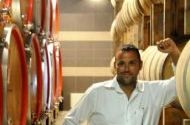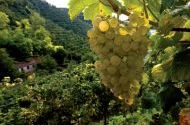Spots of the Leopard: Q&A with Winemaker Francesco Mocavero
Spots of the Leopard: Q&A with Winemaker Francesco Mocavero
(October 6, 2009)It’s grape-picking time in Puglia, and I caught up with Winemaker Francesco Mocavero of Mocavero Winery to discuss how this year’s harvest is going.
It isn’t easy being an aspiring wine writer in the south of Italy. In fact, it isn’t easy being an aspiring wine taster in the south of Italy. Many of the wineries in Puglia are hidden down roads that Google maps won’t acknowledge, and there is a serious lack of road maps and signs.
Some Pugliese wineries do not even have web sites, so finding the source of that impeccable Primitivo means getting your hands dirty. Then there is the issue of language.
In Puglia, where people speak in dialect as well as Italian, English is rarely an option. Tasting and bicycling through Puglia, one of the largest and least-documented wine-producing areas in the world, is both a perilous and highly rewarding experience. I love the people, the fresh smell of ripe vineyards, and the sunsets, all of which are accompanied by the imminent danger of falling into uncomfortable—and highly unpicturesque—situations.
I first met Francesco Mocavero at Il Mercatino Del Gusto—an annual festival organized by Puglia’s Slow Food Movement. On the third day, having tasted over 80 red wines, I was extremely happy to come across his selection of eight reds made from Negroamaro, Primitivo, and Malvasia Nera grapes. Unlike many of the winemakers at the event, Francesco did not let the barrel speak louder than the grape in his line of Reserve wines.
I tasted his 2003 “Santufili” Primitivo Riserva (see review below), and I wrote that it was my favorite red at the event. Our conversation was lively and jokes flew over the open bottles, so that I quickly knew I wanted to interview Francesco. A few weeks later, I called and we arranged it. It was a hot day when my girlfriend and I, loaded with camera gear, bicycled the 12 kilometers to the Mocavero Winery in Arnesano, Italy. We arrived sweaty and a few minutes late and Francesco and his brother, Marco, welcomed us into the winery. We downed a couple glasses of water, then took a brief tour of their new facility, which Francesco gave in Italian. I am much better at understanding Italian than speaking it, especially in regards to wine.
Afterward, we plunked down in the air-conditioned reception area, opened two bottles of Salice Salentino—one aged in stainless steel and the other in American oak—and I asked my first question in English. Francesco smiled politely and said that his English was not so good. I was confused. We had carried on a half-hour conversation in English at the Slow Food festival. Hadn’t we? Hadn’t we told jokes and complex anecdotes? Was it possible that somehow, amid the flowing wine and intoxicating Southern Italian air, I had understood what Francesco was saying…in Italian?
I did not know what to do, exactly. None of my questions were prepared in Italian. The recorder was running. I was feeling exceptionally stupid.
I knew I had to adapt quickly; I had to be professional. My Italian is wimpy, though not completely pathetic, and I tried my best to ask the questions with half-realized yet comprehensible Italian. Luckily, Francesco Mocavero is not a man who minces words. He will tell you honestly what he thinks, and he appreciates it if you return the favor. The finesse he has when creating wines, much of which was passed down from his father, Pietro, reveals his intellectual side, but Francesco also acknowledges that winemaking can be backbreaking work. Mocavero is a family-run winery with a very small staff. “We were testing pH levels in the vineyards just now,” he said with a smile. Similarly, Mocavero wines, which can be found in wine stores in the United States, have an honest, no-nonsense character. They are rustic, yet their many flavors are eloquently balanced.
“The harvest this year is ‘marche di leopardo,’” explains Francesco, “which means the spots of the leopard. It is a local saying that means that some areas are yielding interesting, good-quality grapes, and there are others that are not. The leopard’s spots are where you find the good grapes.”
MB: What are you doing in the vineyards right now?
Francesco Mocavero: Right now we are almost finished with the Chardonnay and have harvested 20–30% of the Primitivo. These Primitivo are from young vines and next week we will begin Primitivo from older vines. We will harvest the grapes that we use for the Santufili Riserva in 10 days to 2 weeks from now. That way the grapes will be more concentrated. After this we do the Negroamaro, which are the last to ripen.
For a good harvest, we need cool temperatures because the plant is already at the end of its cycle. Particularly, we need to have low humidity, so that the grapes mature evenly. These are the two most important things. If the humidity is high, we have problems with parasites.
MB: Is the recent rain a good or a bad thing?
FM: When it is too hot, the rain is a very good thing, because it cools the grapes. But when combined with humidity, it is not good.
MB: Do you use a cool fermentation for all the red wines you make?
FM: Yes. For reds that are younger and destined to be drunk soon, 2009, 2010, or 2011, the maceration is shorter and the temperature is lower. For wines that are going to be aged longer, such as Puteus and Santufili, the maceration lasts throughout the fermentation. We want to extract all of the grape’s substance because the skin and the seeds of the grape give the structure, the color, the aroma, and the tannins.
To keep the color for older wines we keep the temperature around 22-24C for 2 days. For the normal Salice Salentino DOC, the temperature of the fermentation is 20C maximum, in order to achieve more perfume and acidity. We also prefer fewer tannins in the normal Salice Salentino, because it is a drinking wine foremost, so we do not age it in wood barrels.
MB: What’s the process for making the Negroamaro Riserva?
FM: You need grapes that are healthy and whole to age well. The grapes must come off the vines gently. In 2004, the grapes were not exceptional, and we did not make a riserva.
You always need control; today, tomorrow, and the day after. You always need to be watching. You need to be able to directly see the effects of the barrels on the wine and to carefully match the best barrels with the best wine. We’ve found that for Negroamaro, French oak is better. It works better with the characteristics of Negroamaro. For Primitivo, we prefer American oak.
MB: None of your reserve wines see grandi botti (massive, Italian-style wood barrels)?
FM: Puteus is made using only barrique (smaller, French oak barrels). Tela di Ragno is made using grandi botti, and Santufili is made using both barrique and grandi botti.
MB: So, what do when you have spare time?
FM: I go fishing! No, we say that we work every day except Sunday. On Saturday the winery is closed, but you’ll still find us working outside in the vineyards.
2003 “Santufili” Primitivo Riserva
.jpg) First and foremost, Mocavero’s “Santufili” is a behemoth, with a number of powerful, dark flavors that constantly evolve. Decant it. After being open for forty minutes, the wine has a nose of red popsicle, coffee, chocolate, and fruit leather. It has a medium to full body, with bright, green acidity, and an inky mouthfeel. On the second glass, the acidity eases to achieve a stolid balance, like an orchestra coming in tune. The finish is very long and soft, though the tannins do creep up without the accompaniment of food. The acidity makes it a great match with tomato-heavy dishes, such as Bolognese sauce and pasta or meat from the grill, and even bacon-and-mushroom or vegetable quiche.
First and foremost, Mocavero’s “Santufili” is a behemoth, with a number of powerful, dark flavors that constantly evolve. Decant it. After being open for forty minutes, the wine has a nose of red popsicle, coffee, chocolate, and fruit leather. It has a medium to full body, with bright, green acidity, and an inky mouthfeel. On the second glass, the acidity eases to achieve a stolid balance, like an orchestra coming in tune. The finish is very long and soft, though the tannins do creep up without the accompaniment of food. The acidity makes it a great match with tomato-heavy dishes, such as Bolognese sauce and pasta or meat from the grill, and even bacon-and-mushroom or vegetable quiche. This work may not be reproduced, in whole or in part, without prior written permission.
Questo lavoro non può essere riprodotto, in tutto o in parte, senza permesso scritto.








